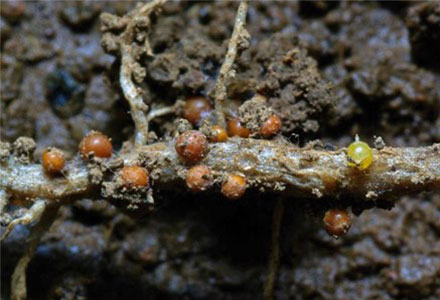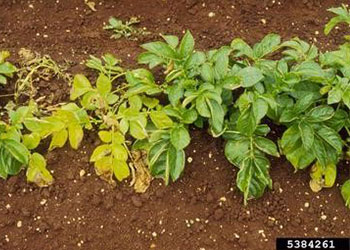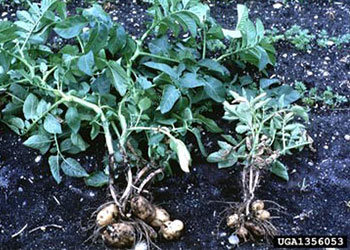PLANT PEST

Gordon Berg, DPI Victoria, PaDIL.
Potato cyst nematode (exotic strains)
Exotic to Australia (white potato cyst nematode), or under management (golden potato cyst nematode)
Features: Nematodes (microscopic worms) that damage potatoes, causing leaf wilting and discolouration, root cysts, reduced roots, dwarfing of the plant and fewer crops
Where it's from: Europe, South and North America, Asia, Africa and New Zealand
How it spreads: Importation of infected plants or plant materials; local spread of cysts via wind, rain, soil, water
and vehicles
At risk: Plants in the Solanaceae family including potato, tomato and eggplant.
Keep it out
Potato cyst nematodes (Globodera spp.) are microscopic worm-like pests. They feed on the roots of potato, tomato, eggplant and other plants from the Solanaceae family. Root damage causes plants to be stunted, with delayed flowering, yellow leaves and wilting, and eventually kills the plant.
The nematodes are very small, less than 1 mm in size, and they produce spherical cysts on roots, which are the size of a pinhead. Cysts contain hundreds of nematode eggs, which are so resilient that they can survive in soil for up to 20 years.
Cysts spread easily by wind, rain, water, or by movement of infected soil sticking to seeds, animals, equipment, clothing and plants.
The exotic strains of this nematode pose a serious threat to potato farming. Potato cyst nematode can cause complete crop failure if not controlled, and if it established in Australia, our trading partners would be likely to reject exports of any produce that could carry the pest.
Importing goods
To keep potato cyst nematode out of Australia, never ignore Australia’s strict biosecurity rules.
Import shipments may need to be treated and certified, so before you import, check our Biosecurity Import Conditions system (BICON).
Stop the spread
One strain, golden nematode (G. rostochiensis), is found in soil in parts of Victoria. Biosecurity measures and quarantine restrictions are in place to ensure it does not spread.
Travelling interstate
Interstate travellers have a role to play in preventing the spread of potato cyst nematode.
Do not enter potato or vegetable farms without permission.
Before you travel interstate or move house, look up your journey on the Australian Interstate Quarantine website to see the restrictions that apply.
What to look for
- Stunted and yellowing crops.
- Roots with cysts attached.


Where to look
Importers
Importation of infested tubers or items that carry soil, including contaminated machinery is the most likely way that potato cyst nematodes could make it to Australia.
Growers and home gardeners
Check:
- potatoes
- tomatoes
- eggplant.
Check the roots of any plants that are stunted and wilting for root damage or cysts, which appear as very tiny white, yellow or brown spheres.
What to do
If you think you’ve found signs of potato cyst nematode:
- take a photo
- contain it without disturbing it (this may be as simple as closing the doors on a shipping container or preventing access to a field).
